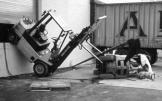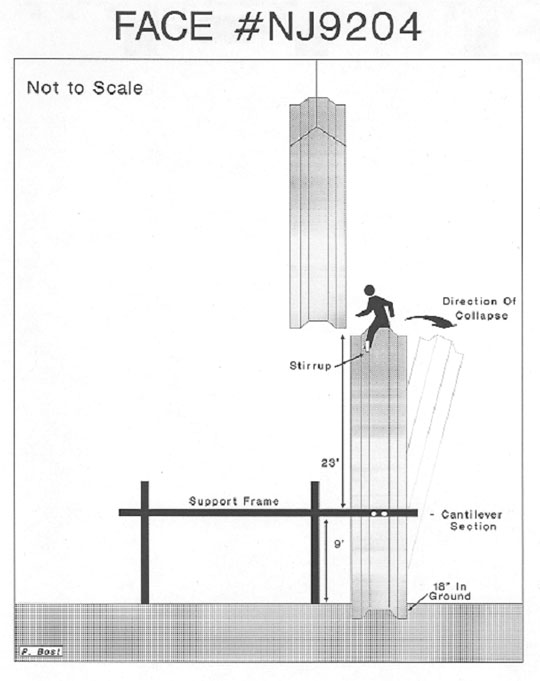

 |
 |
Dock Builder Dies After Falling 35 Feet From a Steel Sheet Pile
April 16, 1992
Investigation: # 92-NJ-024-01
On January 6, 1992, a 31 year-old male dock builder died after falling 35 feet from a section of sheet piling used to construct a wall alongside a highway. The incident occurred while the victim was sitting on top of the steel sheet pile which was vertically mounted on a steel structure. As he was trying to position a second sheet that was being lowered by a crane, the first sheet began to tip over, resulting in the victim jumping from the sheet and falling to the ground.
NJDOH FACE investigators concluded that, in order to prevent similar incidents in the future, these safety guidelines should be followed:
INTRODUCTION
On January 7, 1992, NJDOH FACE personnel were given a newspaper article on a fatal fall that had occurred the previous day. On the same day, FACE investigators consulted the OSHA area office and visited the site with OSHA compliance officers to investigate the incident. The site investigation included interviewing the employer representative, photographing the scene, and taking witness statements. Additional information was obtained from the OSHA case file and medical examiner's report.
The employer was a construction contractor who has been in business for 20 years and employed a total of 150 people. Twenty-five workers were employed at the site where the incident occurred, most of whom were hired from the local trade union halls. The company also employed a safety officer and had a written safety program. The company did not provide training as the dock builders were certified as trained journeymen by the union. The victim was a 31 year-old male dock builder who had been hired from the union hall. The victim had worked for the company for one month on a previous project, and was on his first day on this project after a temporary layoff.
INVESTIGATION
The incident occurred at a construction site alongside a major multi-lane highway running through the state. The highway authority was in the process of widening the road, which first required stabilizing the soil embankments which run alongside the highway. This was done by constructing a temporary wall made of interconnecting steel sheet piles that are driven into the ground between the embankment and the work area. The wall served to protect both the workers and construction site if the hillside collapsed. The sheet piles used to construct the wall were approximately 33 feet long by 4 feet wide, with a thickness of about 1 inch. Each sheet weighed approximately 10,600 pounds and were corrugated for strength. Built into the edges of the sheets were tongue and groove connectors which allowed the sheets to be joined together. The assembled sheets are driven into the ground with a 8-ton vibratory hammer.
The day of the incident was clear and cold. The workers, all hired from the union halls, were on the first day of constructing the wall after a holiday layoff. The crew consisted of six men; four dock builders and two crane operators. Although one dock builder was designated as the foreman, the shop steward for the dock builder's union was in charge of the operation. The crew worked independently from the company and relied on their own experience in constructing the wall, which was to be built following marker stakes placed in the ground by the company engineers.
The crew began work by constructing a steel supporting frame to hold the first sheet pile, the position of which was critical as it would guide the alignment of the following sheets. The frame consisted of two 14 inch H-beams set vertically into the ground with a 14 inch H-beam (crossbeam) welded and bolted to the vertical beams about 9 feet from the ground. One section of the crossbeam extended 14 feet out from the vertical beam, creating a cantilever for attaching the first sheet pile to the frame (see diagram). After the frame was completed, the crane set the first sheet pile vertically on the ground against the cantilever section. The sheet was not driven into the ground but sank about 18 inches into the dirt under its own weight. The sheet was adjusted for alignment (plumb) and then bolted and welded to the cantilever.
At approximately 3 p.m., the victim, acting as the "pile monk", hitched a ride to the top of the sheet pile by standing on the ball of the crane line. Using stirrups (a piece of flat stock steel formed into foot rests), he sat on top of the first sheet to guide the next sheet as it was lowered by the crane. Except for the stirrups, the victim did not use any other type of fall protection. (The use of stirrups as fall protection is accepted industry practice for this procedure because there is no stable structure to tie a conventional safety belt and lanyard to). The victim apparently had some trouble joining the two sheets and rocked and shook the second sheet to align it with the first. While rocking the sheet, the bottom of the sheet he was sitting on kicked out of the ground, pivoting on the point where it was attached to the cantilever. As the sheet began to slowly tip over, the victim jumped from the stirrups, falling and striking his head on the supporting frame before landing on the ground. His co-workers immediately came to his aid and started cardio- pulmonary resuscitation (CPR). CPR was continued after the arrival of the local paramedic and rescue squad who transported the victim to the hospital. The victim was pronounced dead at the hospital emergency room.
CAUSE OF DEATH
The cause of death was attributed by the medical examiner to laceration of the cervical spinal cord and a fractured cervical spine due to a fall from a height.
RECOMMENDATIONS/DISCUSSION
Recommendation #1: When practical, employers should provide and require a manlift for raising and supporting workers when joining sheet piles.
Discussion: In this case, the victim's job required him to sit on a steel sheet pile without the use of effective fall protection. As the standard safety belt and lanyard fall protection is not effective for this type of work, it is recommended that a articulated "cherry picker" manlift should be used to raise and support the pile monk. In situations where the terrain and conditions allow the use of a manlift, this equipment would allow the worker to use fall protection by tying onto the lift while providing the mobility needed for aligning the sheet piles together.
Recommendation #2: Employers should insure that sheet piles are firmly
stabilized before workers are permitted to work on them.
Discussion: In this case, the first sheet pile was inherently top heavy as the attachment point to the cantilever was only 9 feet from the ground. The sheet was also unstable by not being driven into the ground. When the victim tried to join the sheets, he apparently jostled the sheet he was sitting on and created the imbalance that toppled it. To prevent this, the first sheet pile should be firmly stabilized before a worker is permitted to climb on to it. This should be done by driving the sheet firmly into the ground before attaching it to the supporting frame. Stability can be further increased by attaching the sheet to a second crossbeam added to the support frame.
Recommendation #3: Employers must thoroughly plan all work and perform
a job hazard analysis of the site.
Discussion: In this situation, the plans for constructing the wall were not available at the site. The steward and crew used their personal experience to construct the wall, using marker stakes left by the engineers to guide them. It is recommended that all work should be thoroughly planned and documented, taking into account any hazards that may be anticipated. This would include calculating how deep the sheet piles would need to be driven into the ground. A job hazard analysis of the site should then be done before starting the work to identify any additional hazards and plan how to avoid or remediate them.
Recommendation #4: Employers should insure that all OSHA regulations
and established company safety rules are followed.
Discussion: Before the incident, the pile monk rode to the top of the sheet by riding on the weighted ball of the crane line. Although not directly related to the incident, this is a violation of the OSHA Standard 29 CFR 1926.550 (g)(2) and of company safety rules. It is recommended that employers enforce all OSHA regulations and company safety rules by having a company representative supervise worksite activities.
REFERENCES
Code of Federal Regulations 29 CFR 1926, 1989 edition. U.S. Government Printing Office, Office of the Federal Register, Washington DC. pg 162
ILLUSTRATION

NJ
Department of Health & Senior Services Occupational Health Service PO Box 360, Trenton NJ 08625-0360 (609) 984-1863 |